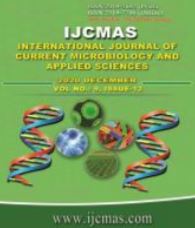


 National Academy of Agricultural Sciences (NAAS)
National Academy of Agricultural Sciences (NAAS)

|
PRINT ISSN : 2319-7692
Online ISSN : 2319-7706 Issues : 12 per year Publisher : Excellent Publishers Email : editorijcmas@gmail.com / submit@ijcmas.com Editor-in-chief: Dr.M.Prakash Index Copernicus ICV 2018: 95.39 NAAS RATING 2020: 5.38 |
The present investigation was carried out to assess the nature and magnitude of genetic variability among various traits and to identify potential donor parents among the forty inbreds lines on the basis of genetic divergence for their use in future breeding programs. Data were recorded on grain yield per plot and various morphometric and biochemical traits. Sufficient genetic variability was observed for all the studied traits. Genetic diversity studies using Mahalanobis D2-statistics grouped inbred lines of maize into seven clusters. Maximum inbred lines were placed in cluster I (13 all non-QPM) followed by cluster II (11 all non-QPM) and cluster III (6 all QPM) which indicated that QPM and non-QPM inbred lines were quite different from each other. Highest intra-cluster distance was observed for cluster VI (597.00) suggesting that the inbred lines in this group possess higher degree of genetic variability. Whereas, maximum inter-cluster distance was observed between clusters II and IV (6276.71) indicating that the inbreds belonging to these clusters would produce the best heterosis effect and have more chances of generating the best recombinants. Cluster mean for different traits showed that the cluster IV exhibited maximum divergence for majority of traits viz., cob placement height, 100-seed weight, cob length, cob girth, grains per row, protein content and tryptophan content. Tryptophan content followed by days to 50 per cent pollen shed and grain yield per plot contributed maximum towards genetic divergence.
 |
 |
 |
 |
 |